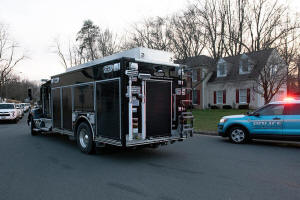Suspect in DC pipe bomb case was 'disappointed' after Trump lost 2020
election, prosecutor says
[December 06, 2025]
By ERIC TUCKER, ALANNA DURKIN RICHER and MICHAEL KUNZELMAN
WASHINGTON (AP) — The man accused of planting a pair of pipe bombs
outside the headquarters of the Republican and Democratic national
parties in Washington on the eve of the U.S. Capitol attack told
investigators he was “disappointed” in the outcome of the 2020
presidential election lost by President Donald Trump, the top federal
prosecutor for the nation's capital said Friday.
U.S. Attorney Jeanine Pirro told ABC News Live that she believes it is
“unmistakable” that Brian Cole Jr. was responsible for placing the pipe
bombs based on evidence collected by investigators. Pirro also suggested
Cole may have been motivated by claims by Trump and his Republican
allies that the 2020 election was stolen from him.
“He was disappointed in various aspects of the election, but this guy
was an equal opportunity bomber," Pirro said. "He was disappointed to a
great deal in the system. Both sides of the system."
Cole confessed to planting the devices on Jan. 5, 2021, two people
familiar with the matter told The Associated Press. Cole also indicated
that he believed conspiracy theories around the 2020 election and
expressed views supportive of Trump, said the people, who were not
authorized to discuss by name an ongoing investigation and spoke on
condition of anonymity.
Cole spoke to law enforcement officers for more than four hours after
his arrest, a federal prosecutor, Charles Jones, said Friday during
Cole’s initial court appearance.

The details add to a still-emerging portrait of the 30-year-old suspect
from Woodbridge, Virginia, and it was not immediately clear what other
information or perspectives he may have shared while cooperating with
law enforcement following his arrest Thursday.
Surveillance video captured the suspect’s movements through the area
where the pipe bombs were placed and the surrounding neighborhood. The
suspect, whose face was obscured by a mask, was wearing a hooded
sweatshirt, gloves and Nike Air Max Speed Turf shoes.
“He told us that he had those sneakers and that he got rid of them after
he placed the pipe bombs,” Pirro said.
The FBI said a comparison of records from nearby cell towers and for
Cole’s cellphone indicate he was near the RNC and DNC around the same
time that the pipe bombs were placed there.
“In my mind, they were on the right path when it was clear that the
cellphone was pinging in the exact locations where we had the video of
the suspect walking along the area,” Pirro said. “Everywhere he walked,
his cellphone was pinging at the cell tower. So it is unmistakable that
he was the guy who was walking along and placing those items.”
[to top of second column]
|

An FBI truck departs the street where the FBI made an arrest and are
investigating a house in Woodbridge, Va., Thursday, Dec. 4, 2025.
(AP Photo/Cliff Owen)

Investigators also obtained credit card records that show Cole
bought items consistent with components used to make the pipe bombs
placed at the RNC and DNC, according to the FBI.
U.S. Magistrate Moxila Upadhyaya ordered Cole to remain in jail
after his first court appearance. He did not enter a plea and is due
back in court Dec. 15 for a detention hearing.
Cole, wearing a tan-colored jail uniform, answered a few routine
questions from the magistrate during Friday's brief hearing.
Relatives of Cole attended the hearing and called out words of
encouragement as he was led out of the courtroom.
“We love you!” one shouted.
“We’re here for you, baby,” another said.
Defense attorney John Shoreman declined to comment on the charges
after the hearing.
“We’re in the very, very early stages,” he said.
Nobody was hurt before the bombs were rendered safe, but the FBI has
said both devices could have been lethal.
The arrest marks the first time investigators have publicly
identified a suspect in an act that has been an enduring mystery for
nearly five years in the shadow of the violent Capitol attack. For
years, the FBI struggled to pinpoint a suspect despite hundreds of
tips, a review of tens of thousands of video files and a significant
number of interviews.
Trump lost the 2020 election to Democrat Joe Biden but promoted
conspiracy theories that Democrats stole the election from him. A
mob of Trump supporters stormed the Capitol on Jan. 6, 2021, after
Trump’s “Stop the Steal” rally near the White House.
All contents © copyright 2025 Associated Press. All rights reserved
 |